Australia was almost defenceless against Japanese attack in 1942. Here it is suggested that vital lessons for today can be learnt from that period. Did the Australian leaders rely too heavily on Britain and were they let down? How much can Australia rely on any country for support in wartime? From the days of the First Fleet it was always accepted that the United Kingdom would send its fleet to defend Australia. For this reason Australia sent troops overseas as early as 1885 to help fight Imperial wars. The situation changed after 1918 for then Japan became a likely enemy. Could Britain defend Australia from attack and conduct a war in Europe? Dr. McCarthy examines both sides of the question and concludes that it was never possible.
- Sorry, this product is unavailable.
-

-
 June, 1942. Johnnie Houlton has arrived in Britain from New Zealand under the Empire Training Scheme only a few months before. From then on and for the next few years, he was almost constantly in action or seeking action with 485 (NZ) Spitfire Squadron. He volunteered for service in Malta and sharply describes the drama of the convoy that took him there and the five months of siege conditions on the island. Houlton vividly recalls the atmosphere and the incidents of the air war from a pilot's-eye view, together with the development and technique of fighter operations - covering daylight bombing missions, low-level bombing and strafing and the formation of the Second Tactical Air Force in support of land forces. Illustrated with black and white photographs.
June, 1942. Johnnie Houlton has arrived in Britain from New Zealand under the Empire Training Scheme only a few months before. From then on and for the next few years, he was almost constantly in action or seeking action with 485 (NZ) Spitfire Squadron. He volunteered for service in Malta and sharply describes the drama of the convoy that took him there and the five months of siege conditions on the island. Houlton vividly recalls the atmosphere and the incidents of the air war from a pilot's-eye view, together with the development and technique of fighter operations - covering daylight bombing missions, low-level bombing and strafing and the formation of the Second Tactical Air Force in support of land forces. Illustrated with black and white photographs. -
 Since the defeat of the Spanish Armada in 1588, the British people have confronted no greater threat to their freedom than in 1940, when Hitler's armies swept through France in a few scant weeks and stood poised twenty-one miles from Dover. Had the Luftwaffe then gained air supremacy over the English Channel, nothing could have prevented the first invasion of Britain in over 900 years. This is the story of how Britain turned the prevailing tide, against all the odds - and won the day. Illustrated with photographs from private collections, drawings, diagrams and charts that clarifies the day by day events on both sides accompanied by text from witnesses and combatants that evoke those few desperate weeks of human endeavour and how the delicate balance was tipped - only just - in Britain's favour.
Since the defeat of the Spanish Armada in 1588, the British people have confronted no greater threat to their freedom than in 1940, when Hitler's armies swept through France in a few scant weeks and stood poised twenty-one miles from Dover. Had the Luftwaffe then gained air supremacy over the English Channel, nothing could have prevented the first invasion of Britain in over 900 years. This is the story of how Britain turned the prevailing tide, against all the odds - and won the day. Illustrated with photographs from private collections, drawings, diagrams and charts that clarifies the day by day events on both sides accompanied by text from witnesses and combatants that evoke those few desperate weeks of human endeavour and how the delicate balance was tipped - only just - in Britain's favour. -
 More and more Australians are reflecting on the soldiers who helped shape our nation. Many are choosing to make pilgrimages to the battlefields of our history, to bring to life names like the Somme, Passchendaele and Ypres. This is the essential companion for anyone visiting the Western Front, presenting well-illustrated walking tours across fourteen of the most important battlefields on easily accessible walking routes, it points out to readers the battlefield landmarks that still exist - the memorials to the men who fought there and the cemeteries where many of them still lie. There are moving quotes and black and white illustrations revealing the experiences of war from the common Aussie digger together with easy-to-follow- directions that allows anyone to visit the battlefields and walk in the footsteps of the first ANZACS.
More and more Australians are reflecting on the soldiers who helped shape our nation. Many are choosing to make pilgrimages to the battlefields of our history, to bring to life names like the Somme, Passchendaele and Ypres. This is the essential companion for anyone visiting the Western Front, presenting well-illustrated walking tours across fourteen of the most important battlefields on easily accessible walking routes, it points out to readers the battlefield landmarks that still exist - the memorials to the men who fought there and the cemeteries where many of them still lie. There are moving quotes and black and white illustrations revealing the experiences of war from the common Aussie digger together with easy-to-follow- directions that allows anyone to visit the battlefields and walk in the footsteps of the first ANZACS. -
 The in-depth inside story of the victory in Africa and Europe by Montgomery's Chief-of-Staff. This is not just a re-telling of the battles and campaigns de Guingand fought with Montgomery, the Eighth Army and the 21st Army Group; it is also an insight into what it takes to get armies equipped and in place to achieve those victories as well as an evaluation of some of the personalities of the leadership of the Western Allies through defeat onward to victory.
The in-depth inside story of the victory in Africa and Europe by Montgomery's Chief-of-Staff. This is not just a re-telling of the battles and campaigns de Guingand fought with Montgomery, the Eighth Army and the 21st Army Group; it is also an insight into what it takes to get armies equipped and in place to achieve those victories as well as an evaluation of some of the personalities of the leadership of the Western Allies through defeat onward to victory. -
 After Singapore falls to the Japanese early in 1942, 70 000 prisoners - including 15, 000 Australians - are held as POWs at the notorious Changi prison, Singapore. To amuse themselves and fellow inmates, a group of sportsmen - led by the indefatigable and popular `Chicken' Smallhorn - created an Australian Football League, complete with tribunal, selection panel, umpires and coaches. The final game of the one and only season was between `Victoria? and the `Rest of Australia', which attracted 10, 000 spectators and a unique Brownlow Medal was awarded in this unlikely setting under the curious gaze of Japanese prison guards. Meet the main characters behind this spectacle: Peter Chitty, the farm hand from Snowy River country with unfathomable physical and mental fortitude, and one of eight in his immediate family who volunteered to fight and serve in WW2; `Chicken' Smallhorn, the Brownlow-medal winning little man with the huge heart; and `Weary' Dunlop, the courageous doctor, who cares for the POWs as they endure malnutrition, disease and often inhuman treatment. Illustrated with black and white photographs.
After Singapore falls to the Japanese early in 1942, 70 000 prisoners - including 15, 000 Australians - are held as POWs at the notorious Changi prison, Singapore. To amuse themselves and fellow inmates, a group of sportsmen - led by the indefatigable and popular `Chicken' Smallhorn - created an Australian Football League, complete with tribunal, selection panel, umpires and coaches. The final game of the one and only season was between `Victoria? and the `Rest of Australia', which attracted 10, 000 spectators and a unique Brownlow Medal was awarded in this unlikely setting under the curious gaze of Japanese prison guards. Meet the main characters behind this spectacle: Peter Chitty, the farm hand from Snowy River country with unfathomable physical and mental fortitude, and one of eight in his immediate family who volunteered to fight and serve in WW2; `Chicken' Smallhorn, the Brownlow-medal winning little man with the huge heart; and `Weary' Dunlop, the courageous doctor, who cares for the POWs as they endure malnutrition, disease and often inhuman treatment. Illustrated with black and white photographs. -

Douglas MacArthur 1880-1964. Inspiring, outrageous, brave, egotistical... A thundering paradox of a man. Douglas MacArthur, one of only five men in history to have achieved the rank of General of the United States Army. He served in World Wars I and II and the Korean War, and is famous for stating that "in war, there is no substitute for victory." This is an examination of an exemplary army career, the stunning successes (and lapses) on the battlefield, and the turbulent private life of the soldier-hero whose mystery and appeal created a uniquely American legend. Illustrated with black and white photos.
-
 A detailed history of the World War II American B-29 Enola Gay, its crew, and the controversial mission to drop the atomic bomb on Hiroshima, Japan. Painstakingly researched, the story behind the decision to send the Enola Gay to bomb Hiroshima is told through firsthand sources. From diplomatic moves behind the scenes to Japanese actions and the US Army Air Force’s call to action, no detail is left untold. Touching on the early days of the Manhattan Project and the first inkling of an atomic bomb, investigative journalist Gordon Thomas and his writing partner Max Morgan-Witts, take WWII enthusiasts through the training of the crew of the Enola Gay and the challenges faced by pilot Paul Tibbets. Illustrated with black and photographs.
A detailed history of the World War II American B-29 Enola Gay, its crew, and the controversial mission to drop the atomic bomb on Hiroshima, Japan. Painstakingly researched, the story behind the decision to send the Enola Gay to bomb Hiroshima is told through firsthand sources. From diplomatic moves behind the scenes to Japanese actions and the US Army Air Force’s call to action, no detail is left untold. Touching on the early days of the Manhattan Project and the first inkling of an atomic bomb, investigative journalist Gordon Thomas and his writing partner Max Morgan-Witts, take WWII enthusiasts through the training of the crew of the Enola Gay and the challenges faced by pilot Paul Tibbets. Illustrated with black and photographs. -
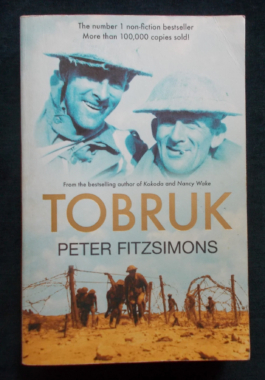
Tobruk: Peter Fitzsimons
$15.00In the dark heart of World War II, when Hitler turned his attentions to conquering North Africa, a distracted and far-flung Allied force could not give its all to the defence of the key city of Tobruk in Libya. So the job was left to the roughest, toughest bunch they could muster. Tobruk is the story of an incredible battle in excruciating desert heat through nine long months, against the might of Adolf Hitler's formidable Afrika Korps. This force's defence of Tobruk against the Afrika Korps' armoured division is one of the great battles of all time, yet rarely talked about. Drawing on extensive source material - including diaries and letters, some never published before - this extraordinary book is the definitive account of this remarkable battle. With black and white photographs. -

Kokoda: Peter Fitzsimons
$12.00The Kokoda Track is the symbol of World War II for Australians. This book takes readers up that tortuous track and into battle with the young men who fought there, following in the footsteps of heroes and villains as they climb the endless mountain ranges, dig into defend, charge into battle or begin the long, desperate and bloody trek to safety. Here can also be found the perspective of the Japanese troops and the extraordinary local people who the Diggers called 'angels'.
-
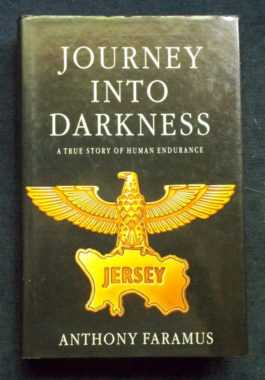 By 194o, the isle of Jersey was well and truly under the Nazi jackboot. The legitimate authorities collaborated with the occupying power. For islander Anthony Faramus, this would have horrific consequences. When the local police reported him to the Germs for possession of a British leaflet, Faramus was jailed for one month. Then the Jersey authorities prosecuted him for defrauding his employer of 90 Occupational Marks. His employer was the collaborationist state, which put him to work in a motel commandeered by the Germans. This time he got six months' hard labour. Shortly after his release, Faramus was sent to Occupied France as a political prisoner. The authorities had sent young Anthony Faramus on the first stage of a journey into the dark heart of Nazi tyranny - but to begin with, imprisonment in France's Fort de R9omainville was surprisingly enjoyable, with fellow prisoners, men and women, from a fascinating cross-section of society. But after Romainville came selections... transports...and the death camps of Buchenwald and Mauthausen...
By 194o, the isle of Jersey was well and truly under the Nazi jackboot. The legitimate authorities collaborated with the occupying power. For islander Anthony Faramus, this would have horrific consequences. When the local police reported him to the Germs for possession of a British leaflet, Faramus was jailed for one month. Then the Jersey authorities prosecuted him for defrauding his employer of 90 Occupational Marks. His employer was the collaborationist state, which put him to work in a motel commandeered by the Germans. This time he got six months' hard labour. Shortly after his release, Faramus was sent to Occupied France as a political prisoner. The authorities had sent young Anthony Faramus on the first stage of a journey into the dark heart of Nazi tyranny - but to begin with, imprisonment in France's Fort de R9omainville was surprisingly enjoyable, with fellow prisoners, men and women, from a fascinating cross-section of society. But after Romainville came selections... transports...and the death camps of Buchenwald and Mauthausen... -
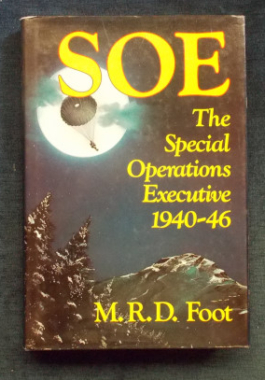
S.O.E. was a small, tough British secret service dirty-tricks department. Its job was to support and stimulate resistance in occupied countries. It was wound up after the war. Its total strength was never more than 10,000 men and 3,200 women, over a third of them secret agents - it exercised vast influence on the war all over the world. This is a readable volume on how S.O.E was created and run, the calibre of the men and women involved, what tools they used and how, when and where they used them, where they did well - and where they did badly. Illustrated with black and white photographs.
-
 The story of the famous Polish Squadron stationed in Britain in Word War II. Their hearts are with their families and loved ones at home but their fears and feelings must be put aside when the German offensive intensifies and they are called up to defend Britain from Hitler's Luftwaffe. Also starring Cara Theobald, Anna Prus and Andrew Woodall.
The story of the famous Polish Squadron stationed in Britain in Word War II. Their hearts are with their families and loved ones at home but their fears and feelings must be put aside when the German offensive intensifies and they are called up to defend Britain from Hitler's Luftwaffe. Also starring Cara Theobald, Anna Prus and Andrew Woodall. -

Munda Trail: Eric Hammel
$10.00The Solomon Island archipelago stretches in a roughly east-west direction from New Guinea to San Cristobal. For the Imperial Japanese forces in 1942, it was a natural highway into the South Pacific. When checked at Guadalcanal, these forces realized they had moved east too quickly, and that their defeat was caused in part by inadequate air bases between the front and their head-quarters at Rabaul, more than six hundred miles away. As the last Japanese battalions were wrecking themselves against the Marine defensive perimeter on Guadalcanal, the decision was made to build the Munda airfield on New Georgia, right in the middle of the Solomons chain. This is the dramatic, harrowing story of green American soldiers encountering for the first time impenetrable swamps, solid rain forests, invisible coconut-log pillboxes, tenacious snipers tied into trees, torren-tial tropical rains, counterattack by enemy aircraft and naval guns, and the logistical nightmare of living and moving in endless mud. -
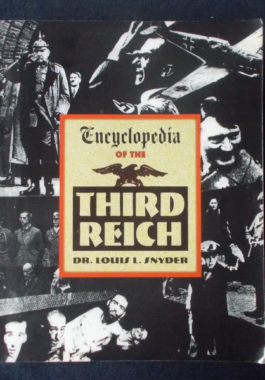 Regarded as a definitive selection of historical information covering all the important people of the time (Resistance members and Nazis); military operations; concepts; organisations of the era as well as those regarded as having been influential to the Nazi ideology. There is a chronology of every important date in the history of the Third Reich from the fall of the Weimar Republic to the end of World War II; a bibliography of pertinent books and articles; essays on art, architecture, film, theater, music, sports, religion, and education; documents such as Hitler's Last Will and his Political Testament and over 200 period photos and drawings.
Regarded as a definitive selection of historical information covering all the important people of the time (Resistance members and Nazis); military operations; concepts; organisations of the era as well as those regarded as having been influential to the Nazi ideology. There is a chronology of every important date in the history of the Third Reich from the fall of the Weimar Republic to the end of World War II; a bibliography of pertinent books and articles; essays on art, architecture, film, theater, music, sports, religion, and education; documents such as Hitler's Last Will and his Political Testament and over 200 period photos and drawings. -

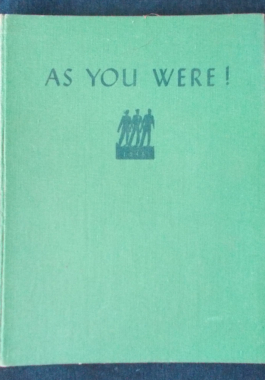 A Cavalcade of Events with The Australian Services from 1788 to 1946. Articles and notes; art and jokes; poetry and cartoons... from the servicemen - and even some of the women - who were there. This is no dry history of battles and dates - it's a memorial to all those fallen in war. Just some of the items in this volume: The Blood-bath at Cowra, E.V. Timms; When Sydney Fought A Zeppelin, 'Matelot'; Bless 'Em All, Biddy Moriarty (Australian Red Cross); Stout Hearts That Never Failed, Ion Idriess; A Service Girl In Japan, A.J. Poppins; and much more, together with art and photographs in black and white and colour - and of course, some typical Australian irreverent cartoons.
A Cavalcade of Events with The Australian Services from 1788 to 1946. Articles and notes; art and jokes; poetry and cartoons... from the servicemen - and even some of the women - who were there. This is no dry history of battles and dates - it's a memorial to all those fallen in war. Just some of the items in this volume: The Blood-bath at Cowra, E.V. Timms; When Sydney Fought A Zeppelin, 'Matelot'; Bless 'Em All, Biddy Moriarty (Australian Red Cross); Stout Hearts That Never Failed, Ion Idriess; A Service Girl In Japan, A.J. Poppins; and much more, together with art and photographs in black and white and colour - and of course, some typical Australian irreverent cartoons. -
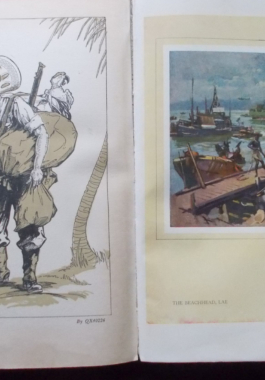
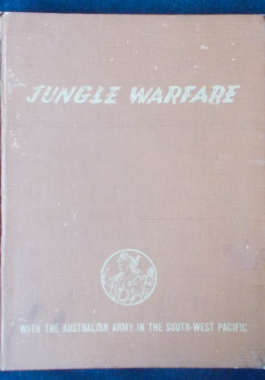
Published for the Australian Military Forces by the Australian War Memorial, Canberra, in 1944. Full of sketches, poems, colour plates and photographs, cartoons and jokes, as well as those fabulous yarns that Aussies can tell so well - and all by the service personnel who were engaged in the South West Pacific during World War II. Contributors are identified only by their service numbers...so your grandfather or great grandfather may be among the authors. Here we do not find battle statistics, plans or generals - just the down to earth Australian Diggers.
-
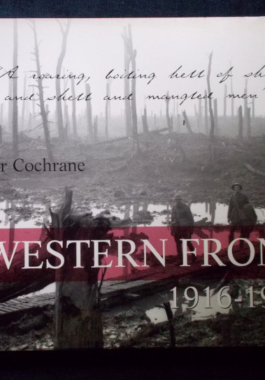 A fascinating, unsettling and unforgettable view of one of the most compelling events in modern history. For all the significance attached to the doomed heroism at Gallipoli, the Western Front was the single greatest wartime tragedy that elicited the greatest sacrifice. Of the 61,720 who died in the course of the war, 46,319 were lost at the Western Front. In a matter of weeks, more Australians were slain in or or two battles than in the entire eight months at Gallipoli. Those terrible years, 1916 to 1918, represent the whole panoply of modern warfare. This is an examination of the record of official and unofficial images in unexpected ways. It looks at the major battles of the campaign, the grim conditions endured by the soldiers, the workers of the massive support system, the valiant efforts of stretcher-bearers and medical workers and, finally, the run of victories under Monash in which Australian soldiers distinguished themselves above and beyond their numerical presence. Illustrated with black and white photographs.
A fascinating, unsettling and unforgettable view of one of the most compelling events in modern history. For all the significance attached to the doomed heroism at Gallipoli, the Western Front was the single greatest wartime tragedy that elicited the greatest sacrifice. Of the 61,720 who died in the course of the war, 46,319 were lost at the Western Front. In a matter of weeks, more Australians were slain in or or two battles than in the entire eight months at Gallipoli. Those terrible years, 1916 to 1918, represent the whole panoply of modern warfare. This is an examination of the record of official and unofficial images in unexpected ways. It looks at the major battles of the campaign, the grim conditions endured by the soldiers, the workers of the massive support system, the valiant efforts of stretcher-bearers and medical workers and, finally, the run of victories under Monash in which Australian soldiers distinguished themselves above and beyond their numerical presence. Illustrated with black and white photographs.





